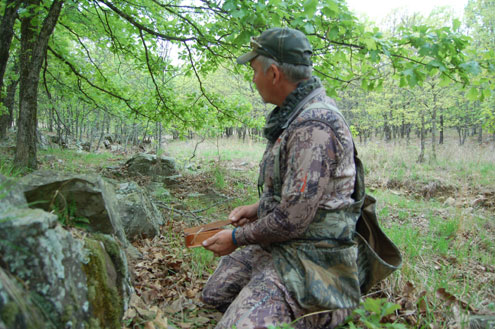I’m a Texan, born and raised and have been singing the praises of all the varied hunting and fishing opportunities our great state offers for many years but, as most outdoors folks will readily agree, it’s fun to explore new opportunities!
We have a tremendous population of wild turkey in Texas but the lion’s share of them are Rio Grande birds. Granted, there are limited opportunities to harvest an Eastern Turkey, mostly in out northeastern counties along the Red River but most Texas turkey hunters go outside our boundaries to harvest their Eastern bird.
Regular readers will remember in last week’s column I mentioned that I was heading up to southeastern Oklahoma to attempt to harvest my first mature eastern bird with my friend Travis Benes, manager of the Choctaw Hunting Lodge. I’ve hunted Rio’s in Texas since the late seventies and been successful in taking one or two just about every season but my experience with Eastern turkey was limited.
After 3 awesome days of hunting with Travis, I came away with a great respect for these ‘woods birds’. Travis knows the 45,000 acres of tribal Choctaw land well and on a couple occasions, had a couple of sneaky gobblers well within my shotgun range. This is where my education on hunting this wary species of wild turkey began.

I’m accustomed to hunting Rio Grande turkeys in relatively open country. Of the sixty or so gobblers I’ve killed through the years, I was looking at the entire bird when I loosed a charge of #4 shot from my shotgun or released an arrow. When hunting the Eastern gobblers, if you wait until you see the entire bird in the heavy cover they call home, you may not be enjoying a wild turkey dinner! I won’t be enjoying a turkey dinner, at least not one prepared from an Eastern bird! But I can truly say that my hunt with Travis will go down as one of the most fun and most definitely the most educational turkey hunts of my life. No, I didn’t kill an Eastern Gobbler but I learned enough to make me a threat next year!
Early the first morning of our hunt, three different gobblers sounded off to Travis’ ‘shock’ gobble, intended to locate birds still on the roost. About thirty minutes after daylight, we had worked off a wooded hillside to a creek bed with a small flowing stream, on the opposite side of the stream the terrain rose sharply. The gobblers were roosting what sounded like a hundred yards or so out.
We quickly positioned ourselves behind some large rocks that were positioned on top of the creek bank and Travis began making some soft, plaintive hen yelps. His calling was so soft that I thought the birds would never hear it but very soon, he had all three gobblers talking back to us. Soft and infrequent calling is the name of the game when hunting Eastern gobblers. Even a mature Rio Grande gobbler will often respond to repeated loud calling but from what I’ve learned, the Eastern birds are not nearly as vocal. I think it could be because of the tight cover in which they live.
Within ten minutes, a big gobbler suddenly appeared, within a few yards of our hen decoy. He never gobbled to tip us off to the presence, he was just there. I had set up so that the elevation allowed me to shoot a bit downhill. The gobbler came in from the higher elevation which made getting a clear shot difficult, the rise in elevation put me at a disadvantage.
He was strutting and displaying within about 25 yards but because of the elevation and timber, I didn’t feel comfortable taking a shot. Finally I saw the boss gobbler’s head and neck appear through a couple of trees and took my shot. The terrain and adjacent trees absorbed the lead and the gobbler took to the air, completely unharmed. I was disappointed in myself at blundering the opportunity but was happy that I didn’t wound the big gobbler.
Travis put another mature gobbler “in my lap” the next day but the bird did not come in as most Rio Grande gobblers would do, rather he circled through some very heavy timber and brush at close range, never allowing me a clear shot. The big bird reminded me of a coyote coming in to a call rather than a wild turkey. These Eastern gobblers are a ‘whole nuther bird’ and I vowed to return for round two next spring.
But there is much more at the Choctaw Hunting Lodge than turkey hunting to lure us across the Red River. The Choctaw land offers some awesome hunting for these big Oklahoma ‘mountain deer’. As a youngster growing up about 18 miles south of the Red River, I remember some of the big bucks taken up in southeastern Oklahoma. Take 45,000 acres of prime whitetail habitat with plenty of browse and natural food to sustain a healthy herd and enhance the habitat with supplemental protein feeding and food plots and it’s easy to guess what these naturally big bucks can become. A free range buck scoring over 180 inches was taken on the Choctaw land last season and Travis says his hunters target mature 150 class bucks, and larger.
Oklahoma offers a wide variety of deer hunting opportunities and at the present, Choctaw Lodge still had a few openings for this fall season. For more information, visit the Choctaw Hunting Lodge web site www.choctawhuntinglodge.com.
Listen to “Outdoors with Luke Clayton and Friends” on radio stations from Nebraska to Texas on weekends or anytime online at www.catfishradio.org.